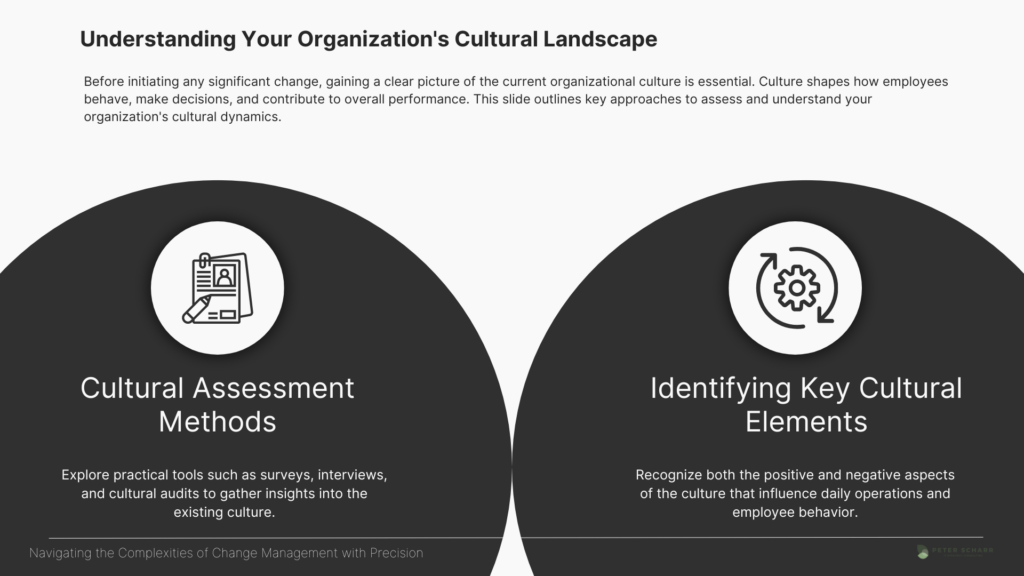Understanding the Need for Cultural Change – Why Organizations Must Evolve
The world is changing faster than ever before. Globalization, rapid technological advancements, and shifting societal values have dramatically impacted the way we work. For organizations to thrive in this dynamic environment, cultural change is not just a buzzword—it’s an essential strategy for survival. Gone are the days when a rigid, one-size-fits-all workplace culture could carry a company through decades of success. Today, a flexible and evolving culture is key to staying relevant and competitive.
But why is cultural change so crucial? Let’s break it down into two main factors: external and internal. By understanding these, we can better appreciate why recognizing the need for change is the critical first step to a successful cultural transformation.
External Drivers of Cultural Change
One of the most obvious forces pushing companies toward cultural evolution is globalization. In a globally connected world, businesses are interacting with diverse markets, employees, and customers from different cultural and geographic backgrounds. As companies expand, they must adapt to these new perspectives, expectations, and ways of working. A rigid culture that worked in one region may not translate well in another, leading to missed opportunities or even conflict. For example, Harvard Business Review highlights how companies that prioritize cultural intelligence are more likely to succeed in international markets.
Similarly, technological advancements are reshaping the workplace at a rapid pace. The rise of remote work, AI-driven tools, and digital collaboration platforms means that the traditional 9-to-5 office culture is becoming obsolete. Companies that fail to embrace these changes risk losing top talent to more adaptive competitors. A study by Gartner underscores how embracing digital transformation can help organizations remain agile and responsive to new business models.
Internal Drivers of Cultural Change
Internal factors are equally important in driving cultural change. One of the most significant is the evolving expectations of today’s workforce. Millennials and Gen Z employees, in particular, value purpose-driven work, flexibility, and inclusivity. A workplace that doesn’t reflect these values may struggle with employee engagement, retention, and productivity. As explained in the next section, the traditional top-down leadership structure is being replaced by more collaborative and transparent approaches, which are better suited to the modern workforce.
Another internal driver is the need for continuous innovation. In a fast-paced world, companies must constantly adapt their products, services, and processes to stay competitive. A culture that encourages experimentation, learning from failure, and cross-functional collaboration is far more likely to foster innovation than one that sticks to the status quo. Take the example of Google, where a culture of creativity and risk-taking has led to groundbreaking innovations like Google Maps and Google Drive.
Recognizing these external and internal forces is the first step in understanding why cultural change is necessary. By embracing this need, organizations can begin to navigate the complexities of change management with precision, ensuring they are well-positioned for future success.
Assessing the Current Organizational Culture – The Foundation for Effective Change
Before diving headfirst into any cultural change initiative, it’s essential to take a step back and evaluate where your organization currently stands. Implementing change without understanding the existing culture is like trying to build a house on shaky ground—you’re setting yourself up for failure. That’s why assessing the current organizational culture is a critical step in navigating the complexities of change management with precision.

But how do you really get a feel for your company’s culture? It’s not just about what’s written in the employee handbook or the values displayed on the walls. It’s about the behaviors, attitudes, and unwritten rules that shape how employees interact, make decisions, and get work done. Let’s explore some of the most effective methods for conducting a cultural assessment and how to identify the key elements that influence your workforce.
Methods for Assessing Organizational Culture
There are several ways to assess the current culture, each offering valuable insights. Here are the most common methods:
- Surveys: One of the quickest ways to gather feedback from a large number of employees is through surveys. These can include questions about values, communication styles, leadership, and overall job satisfaction. A well-designed cultural survey can highlight areas where the organization excels and those in need of improvement. Tools like Glint are commonly used by organizations to regularly monitor employee engagement and cultural alignment.
- Interviews: For a more in-depth understanding, one-on-one or small group interviews can be highly effective. During these conversations, employees can express their thoughts and feelings about the company’s culture in a more personal and candid manner. This qualitative data often reveals underlying issues that might not surface in anonymous surveys.
- Cultural Audits: A cultural audit is a comprehensive examination of an organization’s practices, policies, and behaviors. This audit typically involves reviewing internal communications, performance metrics, and even observing day-to-day operations. The goal is to get a full picture of how the organization functions and whether its stated values align with reality.
Identifying Key Cultural Elements
Once you’ve gathered the data, it’s time to identify the key elements of your organizational culture. This includes both the positive aspects you want to preserve and the negative ones that may be holding the company back. Here are some common elements to consider:
- Core Values: What does your organization stand for? Are these values truly reflected in the actions and behaviors of employees and leadership? For example, if your company prides itself on innovation, but employees feel stifled by red tape, there’s a disconnect between the stated values and the actual culture.
- Leadership Style: Leadership plays a significant role in shaping culture. As mentioned in the previous section, top-down leadership is being replaced by more collaborative approaches. However, if your leaders are still operating in a hierarchical, command-and-control style, this could be a barrier to effective change.
- Employee Behaviors: What are the informal norms that guide employee behavior? Is there a culture of openness and feedback, or do employees feel discouraged from speaking up? Understanding these behaviors can help pinpoint areas where change is most needed.
Why Assessing Culture Matters
Conducting a thorough assessment of your current culture helps you pinpoint the strengths you can build upon and the weaknesses that need addressing. This understanding is critical because, as the saying goes, „you can’t fix what you don’t measure.“ As we explained before, internal factors like employee expectations and the need for innovation drive cultural change. If you don’t have a clear picture of how these factors play out in your organization, any changes you implement could miss the mark.
By taking the time to assess your culture, you also gain valuable insights into how employees perceive the organization. This can foster trust and transparency, two essential ingredients for any successful change initiative. Plus, involving employees in this process shows that their voices are heard and valued, which can boost engagement and commitment to the upcoming transformation.
In short, assessing your current organizational culture is the foundation upon which all change efforts should be built. Without it, you risk making decisions based on assumptions rather than facts. As we move forward, understanding your starting point will allow you to navigate the complexities of change with far greater precision and confidence.
Defining a Vision for Cultural Change – Creating Clarity and Direction
Change without a clear direction is like setting sail without a map—you might move, but you won’t know where you’re going. In the context of cultural change in the workplace, this analogy holds true. Without a well-defined vision, efforts can quickly become disjointed, leading to confusion and resistance among employees. To successfully navigate the complexities of change management, organizations must first establish a compelling vision for what the new culture will look like and how it aligns with broader organizational goals.
As we discussed earlier, understanding the need for cultural change is a crucial first step. But once you’ve assessed your current culture and recognized the forces pushing for change, the next step is to define where you want to go. A clear vision serves as a north star, guiding every decision and action along the way. So, how do you create a vision that resonates with both leadership and employees?
Aligning Cultural Values with Organizational Goals
The most successful cultural change initiatives are those that align closely with the overall goals of the organization. For example, if your company is striving to become more innovative and agile, the culture must support creativity, risk-taking, and collaboration. On the other hand, if your goal is to enhance customer service, a culture of empathy, accountability, and communication will be essential.
Start by asking yourself, „What are the key values that should underpin our workplace culture?“ These values should not only reflect the company’s mission and objectives but also resonate with employees at every level. For instance, companies like Salesforce have successfully aligned their cultural values with their business goals by fostering a culture of equality, trust, and customer success.
Once you’ve identified these core values, it’s essential to communicate how they tie into the company’s broader strategy. Employees are more likely to embrace change when they can see the connection between their daily work and the organization’s long-term vision.
Setting Realistic and Measurable Outcomes
It’s not enough to have an inspiring vision—you also need to set clear, realistic, and measurable outcomes that will help track progress. These outcomes should act as checkpoints along the journey, ensuring that the organization is moving in the right direction.
For example, if your vision is to create a more inclusive workplace, measurable outcomes could include increasing diversity in leadership roles, improving employee satisfaction scores related to inclusivity, or tracking the number of diversity-related initiatives completed each quarter. By setting tangible goals, you give employees something concrete to work toward, which can boost motivation and engagement.
Remember, these outcomes should be dynamic. As the organization evolves, so too should the goals. Flexibility is key to ensuring that your vision remains relevant in a constantly changing environment.
The Importance of Leadership Buy-In
Even the most well-crafted vision will fall flat without leadership buy-in. Leaders set the tone for the organization, and their commitment to the cultural change process is crucial. If leaders aren’t fully on board, employees may view the change as optional or insincere.
Leadership buy-in isn’t just about approving the change—it’s about actively participating in and championing the new culture. Leaders should embody the values of the new culture in their everyday actions, from how they communicate with employees to the decisions they make. For example, if transparency is a core value in the new culture, leaders should be open and honest in their communications, even when addressing challenges.
Additionally, leaders must be ready to address any resistance to change. As explained earlier, employees may feel uncertain or even fearful of change, especially if it threatens to disrupt their routines. Leaders who acknowledge these concerns and provide support can help ease the transition. A great example of leadership buy-in can be found in the case of IBM’s transformation, where top executives took an active role in driving the shift toward a more agile and innovative culture.
Communicating the Vision Effectively
Finally, once the vision is defined and leadership is aligned, it’s time to communicate the vision across all levels of the organization. Clear, consistent, and transparent communication is key to ensuring that every employee understands and buys into the cultural change.
This communication should be more than just a one-time announcement. It should be an ongoing dialogue that reinforces the vision through multiple channels—whether it’s through company meetings, internal newsletters, or team huddles. Employees need to hear the vision repeatedly and see how it connects to their day-to-day responsibilities.
Moreover, communication should be two-way. Employees should feel comfortable providing feedback and asking questions about the vision. Creating an environment of psychological safety, where employees can voice their concerns without fear of judgment, is vital to ensuring that the vision takes root.
In summary, defining a vision for cultural change is an essential step in navigating the complexities of change management.
Take care,


